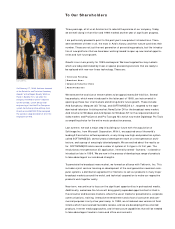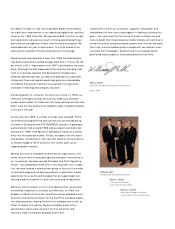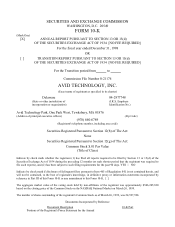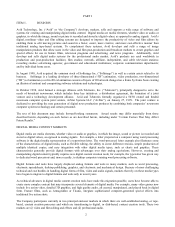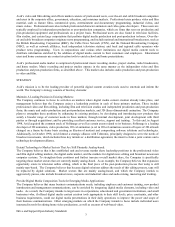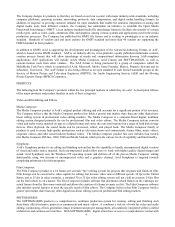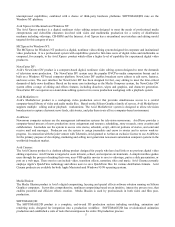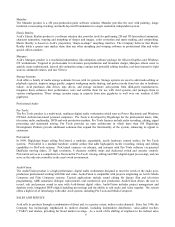Avid 1998 Annual Report Download - page 7
Download and view the complete annual report
Please find page 7 of the 1998 Avid annual report below. You can navigate through the pages in the report by either clicking on the pages listed below, or by using the keyword search tool below to find specific information within the annual report.2
PART I
ITEM 1. BUSINESS
Avid Technology, Inc. (“Avid” or “the Company”) develops, markets, sells and supports a wide range of software and
systems for creating and manipulating digital media content. Digital media are media elements, whether video or audio or
graphics, in which the image, sound or picture is recorded and stored as digital values, as opposed to analog signals. Avid’ s
digital, nonlinear video and film editing systems are designed to improve the productivity of video and film editors by
enabling them to edit moving pictures and sound in a faster, easier, more creative, and more cost-effective manner than
traditional analog tape-based systems. To complement these systems, Avid develops and sells a range of image
manipulation products that allow users in the video and film post-production and broadcast markets to create graphics and
special effects for use in feature films, television programs and advertising, and news programs. Additionally, Avid
develops and sells digital audio systems for the professional audio market. Avid’ s products are used worldwide in
production and post-production facilities; film studios; network, affiliate, independent, and cable television stations;
recording studios; advertising agencies; government and educational institutions; corporate communication departments;
and by individual home users.
In August 1998, Avid acquired the common stock of Softimage Inc. (“Softimage”) as well as certain assets related to its
business. Softimage is a leading developer of three-dimensional (“3D”) animation, video production, two-dimensional
(“2D”) cel animation (a cel in 2D cel animation consists of layers of 2D artwork changed on a frame by frame basis creating
an illusion of motion) and compositing software solutions and technologies.
In October 1998, Avid formed a strategic alliance with Tektronix, Inc. (“Tektronix”), principally designed to serve the
needs of broadcast newsrooms, which includes three key initiatives: a distribution agreement, the formation of a joint
venture and a technology development alliance. Avid and Tektronix formally organized a 50/50 owned and funded
newsroom computer system joint venture, AvStar Systems LLC (“AvStar”), on January 27, 1999. The joint venture is
dedicated to providing the next generation of digital news production products by combining both companies’ newsroom
computer systems technology and certain personnel.
The text of this document may include forward-looking statements. Actual results may differ materially from those
described herein, depending on such factors as are described herein, including under “Certain Factors That May Affect
Future Results.”
DIGITAL MEDIA CONTENT MARKETS
Digital media are media elements, whether video or audio or graphics, in which the image, sound or picture is recorded and
stored as digital values, as opposed to analog signals. For example, a letter prepared on a computer using word processing
software is the digital media representation of a typewritten letter. The word-processed letter example also illustrates some
of the characteristics of digital media, such as flexible editing, the ability to create different versions, simple production of
multiple identical copies, and easy integration with other digital media types, such as charts and graphics. These
characteristics generally provide digital formats with advantages over their analog equivalents. However, creating and
manipulating digital content typically requires new digital content creation tools; for example, the typewriter has given way
to dedicated word processors and, more recently, to desktop computers running word processing software.
Digital formats and tools have largely displaced analog formats and tools in many markets, such as word processing,
electronic spreadsheets, desktop publishing, graphics, and electronic and mechanical design. Because of more challenging
technical and cost hurdles in handling digital forms of film, video and audio signals, markets that rely on these media types
have begun to migrate to digital formats and tools only in recent years.
As technical advances in digital media content creation tools have made this migration possible, users have become able to
create more complex content that may incorporate several elements of digital media. For example, many video games now
include live action video, detailed 3D graphics, and high quality audio, all created, manipulated, and played back in digital
form. Feature films, such as Armageddon or Titanic, integrate sophisticated computer-generated special effects into
traditional live action shots.
The Company participates currently in two principal end-user markets in which there are well-established analog, or tape-
based, content creation processes and which are transitioning to digital, or disk-based, content creation tools. These two
markets are (i) video and film editing and effects and (ii) professional audio.


